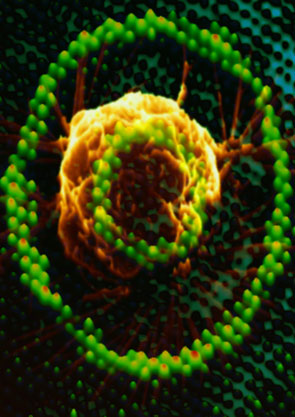| Posted: Apr 26, 2010 | |
Will brain-like evolutionary circuit lead to intelligent computers? |
|
| (Nanowerk Spotlight) Even though traditional, digital computers have consistently increased in speed and complexity – the most powerful computers today are blistering fast with capabilities of executing more than 1000 trillion executions per second (petaflops) – they are limited by their reliance on sequential processing of instructions; i.e. no matter haw fast they are, they still process only one bit at a time. By contrast, individual neurons in our brain are very slow: they fire at only about 1000 times per second; however, since they are operating in a massively parallel way, with millions of neurons working collectively, they are able to complete certain tasks more efficiently than even the fastest super-computer. Another important distinction of our brain is that, during computing, information processing circuits evolve continuously to solve complex problems. | |
| An international research team from Japan and Michigan Technological University (MTU) has now created a similar process of circuit evolution in an organic molecular layer, which also solves complex problems. This brain-like 'evolutionary' circuit has been realized for the first time in the world. | |
| "Our computer is massively parallel" Anirban Bandyopadhyay tells Nanowerk. "Whereas the world's fastest supercomputers process bits sequentially in each their channels, our circuit allows instantaneous changes of ∼300 bits at a time. Our processor can produce solutions to problems for which algorithms on computers are unknown, like predictions of natural calamities and outbreak of diseases." | |
| Bandyopadhyay, a scientist at the Advanced Nano Characterization Center at the National Institute of Materials Science (NIMS) in Tsukuba, Japan, is first author of a paper in Nature Physics ("Massively parallel computing on an organic molecular layer") that demonstrates an assembly of molecular switches that simultaneously interact to perform a variety of computational tasks including conventional digital logic, calculating Voronoi diagrams, and simulating natural phenomena. | |
| "Our processor can produce solutions to problems for which algorithms on computers are unknown, like predictions of natural calamities and outbreaks of disease," explains Bandyopadhyay. "To prove this unique feature, we have mimicked two natural phenomena in the molecular layer: heat diffusion and the evolution of cancer cells at the molecular scale." | |
  |
|
| Left: Mimicking natural phenomenon – evolution of a cancer cell. Right: Diffusion on molecular layer with simulation. (Images: Dr. Bandyopadhyay, NIMS) | |
| To match the power of a bio-processor, hardware must be dynamic and it should evolve along with the encoded problem, as proposed by Hopfield and Tank in 1987 ("Collective computation in neuronlike circuits"). It appears that, after 23 years, this team has now realized that technology in practice using an assembly of molecular switches. | |
| According to Bandyopadhyay, their evolutionary circuit is based on the Cellular Automaton model, which was proposed in 1955 by John von Neumann. For the first time this model has now been realized physically by molecular monolayers. | |
| "As an alternative to serial logic operation, von Neumann demonstrated parallel computing on a piece of graph paper by moving black and white dots together using simple rules," he says. "To implement such a cellular automaton (CA) in hardware, each cell representing the dots should communicate with its neighbors simultaneously to generate a collective decision." | |
| In their work, instead of wiring single molecules/CA cells one-by-one, the researchers directly build a molecular switch assembly where ∼300 molecules continuously exchange information among themselves to generate the solution. This molecular assembly functions similarly to the graph paper of von Neumann, where excess electrons move like colored dots on the surface, driven by the variation of free energy that leads to emergent computing. | |
| "We demonstrate the ability of a CA cell to change its neighborhood from 2 to 6 CA cells in a controlled manner" explains Bandyopadhyay. "Physically, it means that a molecule could interact locally with up to 6 molecules at a time during information processing. It should be noted that in the human brain, a neuron communicates with up to 10000 neighboring neurons at a time, and neural circuits evolve continuously during their life-span." | |
| By separating a monolayer from the metal ground with an additional monolayer, the NIMS/MTU team developed a generalized approach to make the assembly sensitive to the encoded problem. The assembly adapts itself automatically for a new problem and redefines the CA rules in a unique way to generate the corresponding solution. | |
| "You could say that we have realized organic monolayers with an IQ" says Bandyopadhyay. "Our monolayer has intelligence." | |
| Furthermore, he points out that this molecular processor heals itself if there is any defect. It achieves this remarkable self-healing property from the self-organizing ability of the molecular monolayer. | |
| "No existing man-made computer has this property, but our brain does: if a neuron dies, another neuron takes over its function" he says. | |
| With such remarkable processors that can replicate natural phenomena at the atomic scale researchers will be able to solve problems that are beyond the power of current computers. Especially ill-defined problems, like the prediction of natural calamities, prediction of diseases, and Artificial Intelligence, will benefit from the huge instantaneous parallelism of these molecular templates. | |
| According to Bandyopadhyay, robots will become much more intelligent and creative than today if his team's molecular computing paradigm is adopted. | |
| "Current robots cannot cope with changing environments, and they will be unable to survive in more hostile environments than those they were programmed for. Their intelligence is very limited, even when compared to viruses and bacteria. With our hardware, robots can take many decisions at a time, which no computer can do. They can come up with new solutions nearly for infinite times which we can never expect from a normal robot." | |
 By
Michael
Berger
– Michael is author of three books by the Royal Society of Chemistry:
Nano-Society: Pushing the Boundaries of Technology,
Nanotechnology: The Future is Tiny, and
Nanoengineering: The Skills and Tools Making Technology Invisible
Copyright ©
Nanowerk LLC
By
Michael
Berger
– Michael is author of three books by the Royal Society of Chemistry:
Nano-Society: Pushing the Boundaries of Technology,
Nanotechnology: The Future is Tiny, and
Nanoengineering: The Skills and Tools Making Technology Invisible
Copyright ©
Nanowerk LLC
|
|
|
Become a Spotlight guest author! Join our large and growing group of guest contributors. Have you just published a scientific paper or have other exciting developments to share with the nanotechnology community? Here is how to publish on nanowerk.com. |
|
